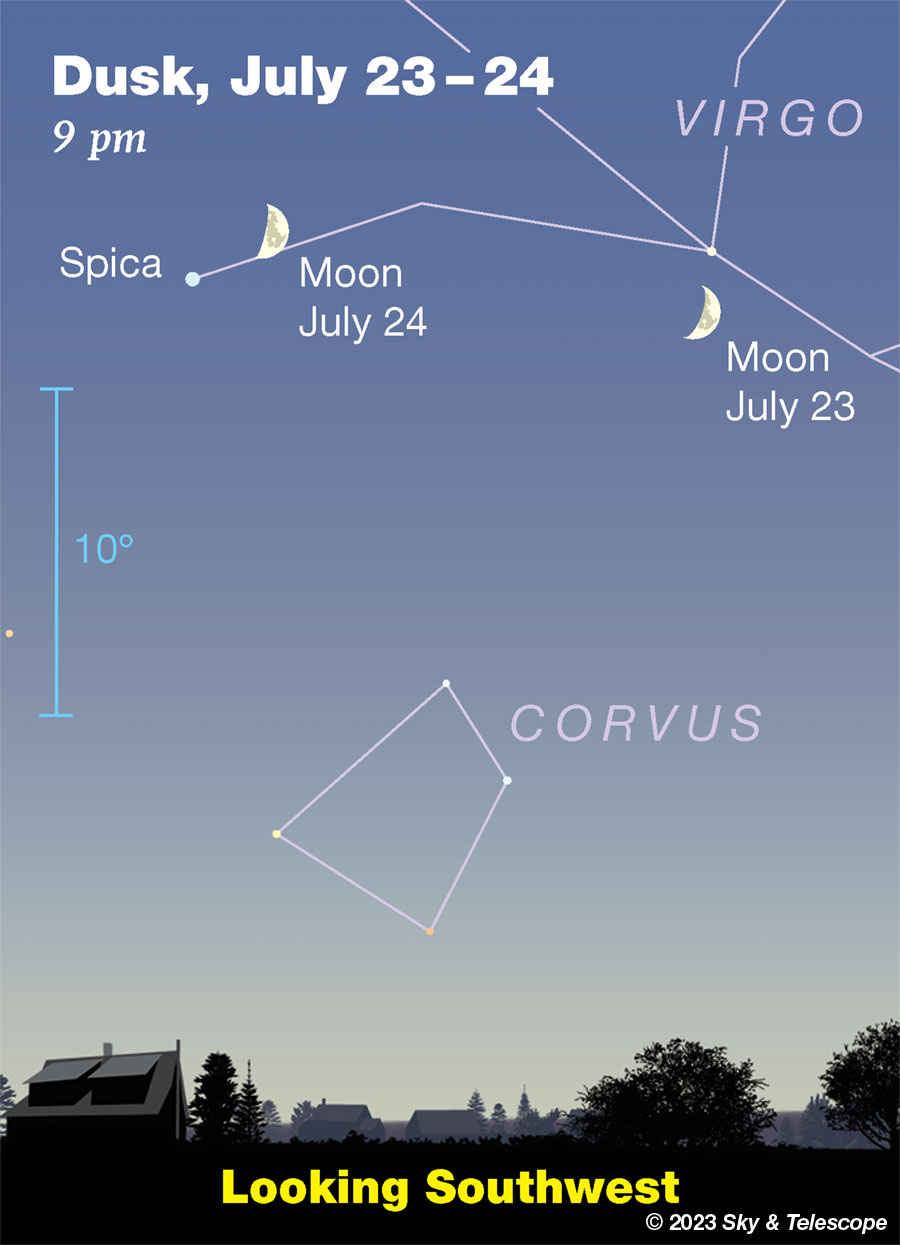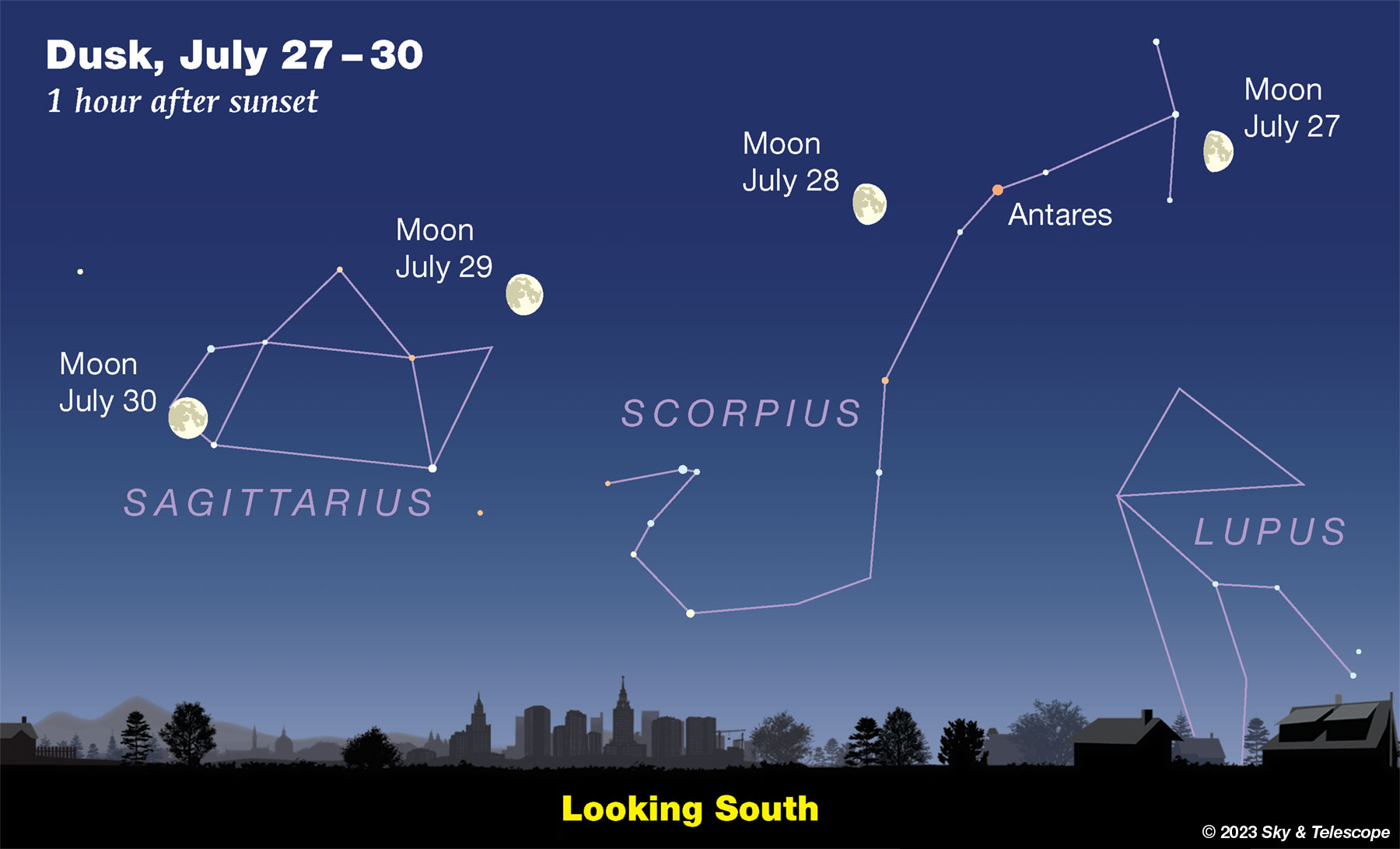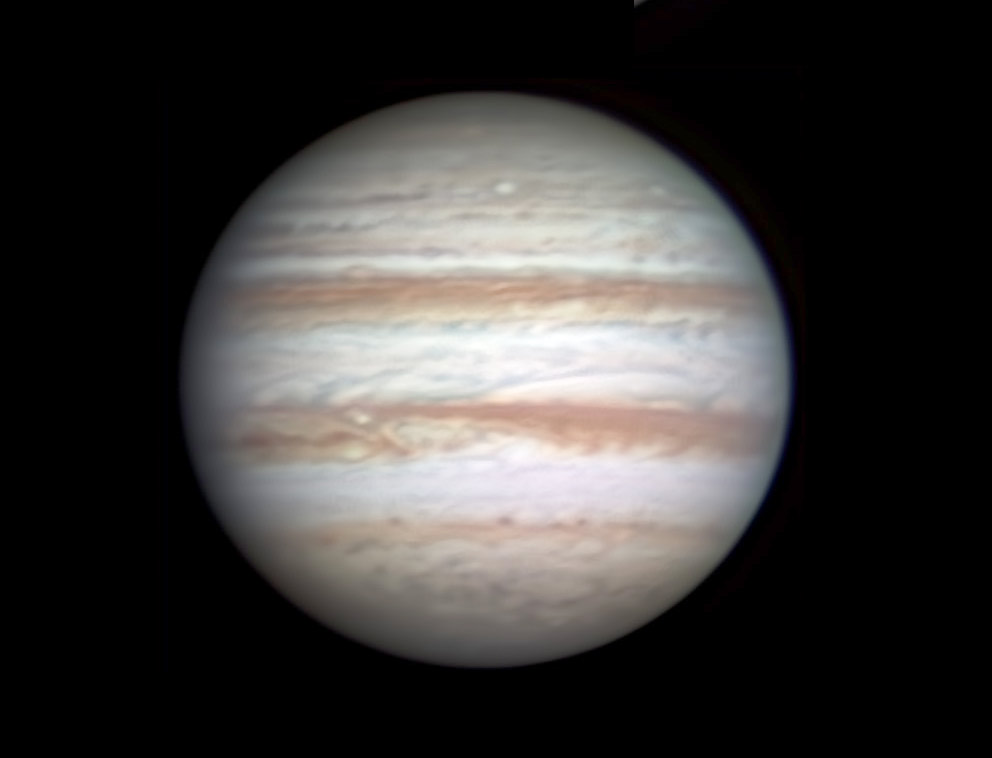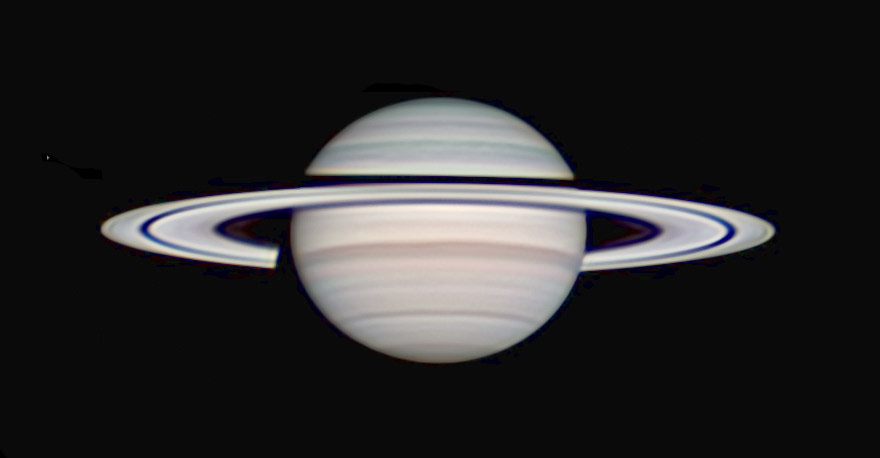FRIDAY, JULY 21
■ In late twilight, look about a fist at arm's length above the Moon for Denebola, Beta Leonis. That's the tip of Leo's tail. Because this is late July, Leo is going goodbye.
SATURDAY, JULY 22
■ A twilight challenge. Spot the crescent Moon in the west-southwest about 30 minutes after sunset. Look for Venus about three fists at arm's length to its lower right. Fainter Mercury, even fainter Regulus, and puny Mars form a straight diagonal line a little way above Venus. The line is about fist and a half long and runs from lower right to upper left.
SUNDAY, JULY 23
■ To me, the thick waxing crescent is one of the most interesting phases for exploring the Moon's terminator with a telescope. And this evening, above or upper right of the Moon by a couple degrees is 3rd-magnitude Gamma Virginis (Porrima), a fine close telescopic double star for telescopes. Its components are 3.3 arcseconds apart this year, oriented almost north-south. They're both magnitude 3.5.

■ It's late July. . . so can you catch the heliacal rising of Rigel and Orion's Belt — far out of season! — low in the brightening dawn? See the July Sky & Telescope, page 50.
MONDAY, JULY 24
■ With the advance of summer the Sagittarius Teapot, in the south-southeast after dark now, is starting to tilt and pour from its spout to the right. The Teapot will tilt farther and farther to pour for the rest of the summer — or for much of the night if you stay out late.
TUESDAY, JULY 25
■ First-quarter Moon (exact at 6:07 p.m. EDT, when the Moon is in afternoon view for North America). After dark, look for Spica a fist to the Moon's lower right. Much higher, about three fists upper right of the Moon shines bright Arcturus. A similar distance to the Moon's left is orange Antares in Scorpius.
■ As summer progresses, Arcturus always moves down the western side of the evening sky. It forms the bottom point of the Kite of Boötes. The Kite, rather narrow, extends upper right from Arcturus by 23°, about two fists at arm's length.
The top of the kite is bent slightly down. The kite's short tail currently hangs nearly straight down from Arcturus.
WEDNESDAY JULY 26
■ We're not yet halfway through summer, but already W-shaped Cassiopeia, a high constellation of fall and winter evenings, is climbing up in the north-northeast as evening grows late. And the Great Square of Pegasus, emblem of fall, comes up to balance on one corner just over the eastern horizon.
THURSDAY, JULY 27
■ This evening for North America, the waxing gibbous Moon shines just to the right of the head-of-Scorpius stars: a nearly vertical row of three. The brightest of these is the middle one, Delta Scorpii, just to the Moon's upper left, as shown below. Somewhat farther left is the orange-red supergiant Antares.

FRIDAY, JULY 28
■ Now the Moon shines just a few degrees left of Antares through the evening, as shown above. But of course they're not the slightest bit close together. The Moon is 1.3 light-seconds from us. Antares, at a distance of about 550 light-years, is some 13 billion times farther away. Moreover, Antares is estimated to be almost 200,000 times larger in diameter. Nowhere in human experience but astronomy are things so different than they appear.
SATURDAY, JULY 29
■ The Moon hangs just off the spout of the Sagittarius Teapot this evening, as shown above. Binoculars may help you pick out the Teapot stars through the moonlight. Remember that the Teapot is about twice as wide as a typical binocular's field of view, so expect to sweep around a bit to get it all.
SUNDAY, JULY 30
■ Now the Moon is on the other edge of the Teapot: in its handle. Again, use binocs to pick the stars out of the moonlight if necessary.
This Week's Planet Roundup
Mercury is deep in the glow of sunset, in the vicinity of brighter Venus. Start looking for them about 20 minutes after sunset. Binoculars help.
Mercury is 10° to Venus's right on July 21st. It moves to 6° above Venus by the 28th. During that time Mercury fades slightly, from magnitude –0.3 to 0.0.
On July 28th Mercury is passing very close by fainter Regulus, magnitude +1.4. They'll be only 0.1° or 0.2° apart as seen in twilight from the longitudes of the Americas. Use binoculars or better, a telescope. In a telescope Mercury will be very tiny (6.2 arcseconds diameter) and gibbous.
Venus (magnitude –4.5) is getting very low in bright twilight, more so every day. Use binoculars to look for it due west starting 15 or 20 minutes after sunset.
Get your telescope on Venus during late afternoon if you can, while it's higher in a clear blue sky. (Be careful not to sweep across the Sun by accident!) Venus is a tiny, thin white crescent, enlarging and thinning as it swings closer to Earth and ever closer to our line of sight to the Sun. From July 21st to 28th it expands from 46 to 51 arcseconds in diameter while waning from 15% to 9% sunlit. But really, by as late as the 28th it will be gone from sight altogether.
Mars (only magnitude +1.8!) glows weakly upper left of Venus and Regulus as twilight deepens. Mars and Venus are 9½° apart on July 21st, and 12° by the 25th. Good luck.
Don't confuse Mars with sparkly Regulus, magnitude +1.4, which is nearer to Venus.
Jupiter (magnitude –2.4, in Aries) rises around midnight or 1 a.m. in the east-northeast. By the beginning of dawn it shines very high toward the southeast.

Saturn (magnitude +0.7, in dim Aquarius) rises in late twilight. It's highest in the south, and sharpest and steadiest in a telescope, before the first glimmers of dawn.

Uranus, magnitude 5.8 in Aries, is high in the east by the beginning of dawn. It's about 10° lower left of Jupiter.
Neptune, magnitude 7.9 at the Aquarius-Pisces border, rises after dark and is high in the south-southeast before dawn begins, about 2o° east of Saturn.
All descriptions that relate to your horizon — including the words up, down, right, and left — are written for the world's mid-northern latitudes. Descriptions and graphics that also depend on longitude (mainly Moon positions) are for North America.
Eastern Daylight Time (EDT) is Universal Time minus 4 hours. UT is sometimes called UTC, GMT, or Z time.
Want to become a better astronomer? Learn your way around the constellations. They're the key to locating everything fainter and deeper to hunt with binoculars or a telescope.
This is an outdoor nature hobby. For a more detailed constellation guide covering the whole evening sky, use the big monthly map in the center of each issue of Sky & Telescope, the essential magazine of astronomy.
Once you get a telescope, to put it to good use you'll need a much more detailed, large-scale sky atlas (set of charts). The basic standard is the Pocket Sky Atlas (in either the original or Jumbo Edition), which shows all stars to magnitude 7.6.

Next up is the larger and deeper Sky Atlas 2000.0, plotting stars to magnitude 8.5; nearly three times as many. The next up, once you know your way around, are the even larger Interstellarum atlas (stars to magnitude 9.5) or Uranometria 2000.0 (stars to mag 9.75). And be sure to read How to Use a Star Chart with a Telescope. It applies just as much to charts on your phone or tablet as to charts on paper.
You'll also want a good deep-sky guidebook. A beloved old classic is the three-volume Burnham's Celestial Handbook. An impressive more modern one is the big Night Sky Observer's Guide set (2+ volumes) by Kepple and Sanner.
Do computerized telescopes replace charts? Not for beginners I don't think, especially not on mounts and tripods that are less than top-quality mechanically. Unless you really prefer spending your time getting finicky technology to work rather than getting to know the sky. As Terence Dickinson and Alan Dyer say in their Backyard Astronomer's Guide, "A full appreciation of the universe cannot come without developing the skills to find things in the sky and understanding how the sky works. This knowledge comes only by spending time under the stars with star maps in hand."
But finding very faint objects the old-fashioned way with charts isn't simple either. See How to Use a Star Chart with a Telescope to learn the tricks.
![]() Audio sky tour. Out under the evening sky with your
Audio sky tour. Out under the evening sky with your
earbuds in place, listen to Kelly Beatty's monthly
podcast tour of the naked-eye heavens above. It's free.
"The dangers of not thinking clearly are much greater now than ever before. It's not that there's something new in our way of thinking, it's that credulous and confused thinking can be much more lethal in ways it was never before."
— Carl Sagan, 1996
"Facts are stubborn things."
— John Adams, 1770
 3
3









Comments
misha17
July 21, 2023 at 4:50 pm
The variable star Mira was at maximum in mid-June, but was rising around the time of twilight.
It's fainter now, but should easier to see in the dark skies before dawn. Look below and to the right of Jupiter in the lower "body" of Cetus the Whale. Don't confuse it with Menkar, which is one on the stars in the "tail" of Cetus. Menkar is more directly below Jupiter.
You must be logged in to post a comment.
mary beth
July 23, 2023 at 8:42 pm
Thanks! Had to look this up, and sure enjoyed reading about it. I read the apparent magnitude varies from about 2 to 10.1. What a range!
You must be logged in to post a comment.
Zubenelgenubi 61
July 25, 2023 at 11:56 am
I think the article is a little too pessimistic on Venus' visibility. Of course much depends upon the haziness of the atmosphere, but I have seen Venus with the unaided eye when it sets as little as 45 minutes after sunset. I'm sure others have done much better. This would make it visible to the unaided eye through about the 28th at the latitude of St. Louis. On August 1st, it sets about 26 minutes after sunset from St. Louis and 36 minutes after sunset in New Orleans. On a good clear night, it should be binocular visible from both locations, and possibly naked-eye visible from New Orleans. Because of Venus being well south of the Sun, it sets at around the time of sunset as early as about August 7th, but it should be quite possible to block out the Sun with a building in the late afternoon and spot it about 10 degrees to the left of the Sun.
You must be logged in to post a comment.
You must be logged in to post a comment.